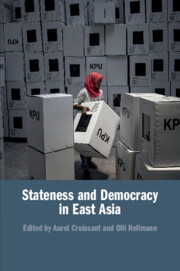Book contents
- Stateness and Democracy in East Asia
- Stateness and Democracy in East Asia
- Copyright page
- Contents
- Figures
- Tables
- Contributors
- Acknowledgements
- 1 Introduction: Rethinking Stateness and Democracy in East Asia
- 2 State-Building and Democratization
- 3 South Korea’s Democracy and the Legacies of the Developmental State
- 4 After Hegemony: State Capacity, the Quality of Democracy and the Legacies of the Party-State in Democratic Taiwan
- 5 Democratization Interrupted: The Parallel State and the Demise of Democracy in Thailand
- 6 Weak State and the Limits of Democratization in Cambodia, 1993–2017
- 7 The Institutional Roots of Defective Democracy in the Philippines
- 8 Stateness and State Capacity in Post-Authoritarian Indonesia: Securing Democracy’s Survival, Entrenching Its Low Quality
- 9 As Good as It Gets? Stateness and Democracy in East Timor
- 10 Stateness and Democracy: Evidence from East Asia and Cross-Regional Comparisons
- Index
- References
10 - Stateness and Democracy: Evidence from East Asia and Cross-Regional Comparisons
Published online by Cambridge University Press: 13 May 2020
- Stateness and Democracy in East Asia
- Stateness and Democracy in East Asia
- Copyright page
- Contents
- Figures
- Tables
- Contributors
- Acknowledgements
- 1 Introduction: Rethinking Stateness and Democracy in East Asia
- 2 State-Building and Democratization
- 3 South Korea’s Democracy and the Legacies of the Developmental State
- 4 After Hegemony: State Capacity, the Quality of Democracy and the Legacies of the Party-State in Democratic Taiwan
- 5 Democratization Interrupted: The Parallel State and the Demise of Democracy in Thailand
- 6 Weak State and the Limits of Democratization in Cambodia, 1993–2017
- 7 The Institutional Roots of Defective Democracy in the Philippines
- 8 Stateness and State Capacity in Post-Authoritarian Indonesia: Securing Democracy’s Survival, Entrenching Its Low Quality
- 9 As Good as It Gets? Stateness and Democracy in East Timor
- 10 Stateness and Democracy: Evidence from East Asia and Cross-Regional Comparisons
- Index
- References
Summary
The concluding chapter summarizes and synthesizes findings across the different country. This exercise reveals two key points regarding the state-democray nexus. First, stateness is neither a sufficient nor a necessary condition for democratic consolidation. Not only can newly democratising regimes be subject to path-dependent effects but intervening variables – in particular, the organization of particularistic networks - also play a role. Second, democracy will only have a strengthening effect on stateness if all partial regimes are sufficiently consolidated. That is to say, defective democracies do not produce strong incentives for political elites to invest in state-building. These findings are placed in a comparative perspective with ‘third-wave’ democracies in other parts of the world, which shows that our causal mechanisms travel beyond East Asia.
Keywords
- Type
- Chapter
- Information
- Stateness and Democracy in East Asia , pp. 233 - 262Publisher: Cambridge University PressPrint publication year: 2020
References
- 1
- Cited by



